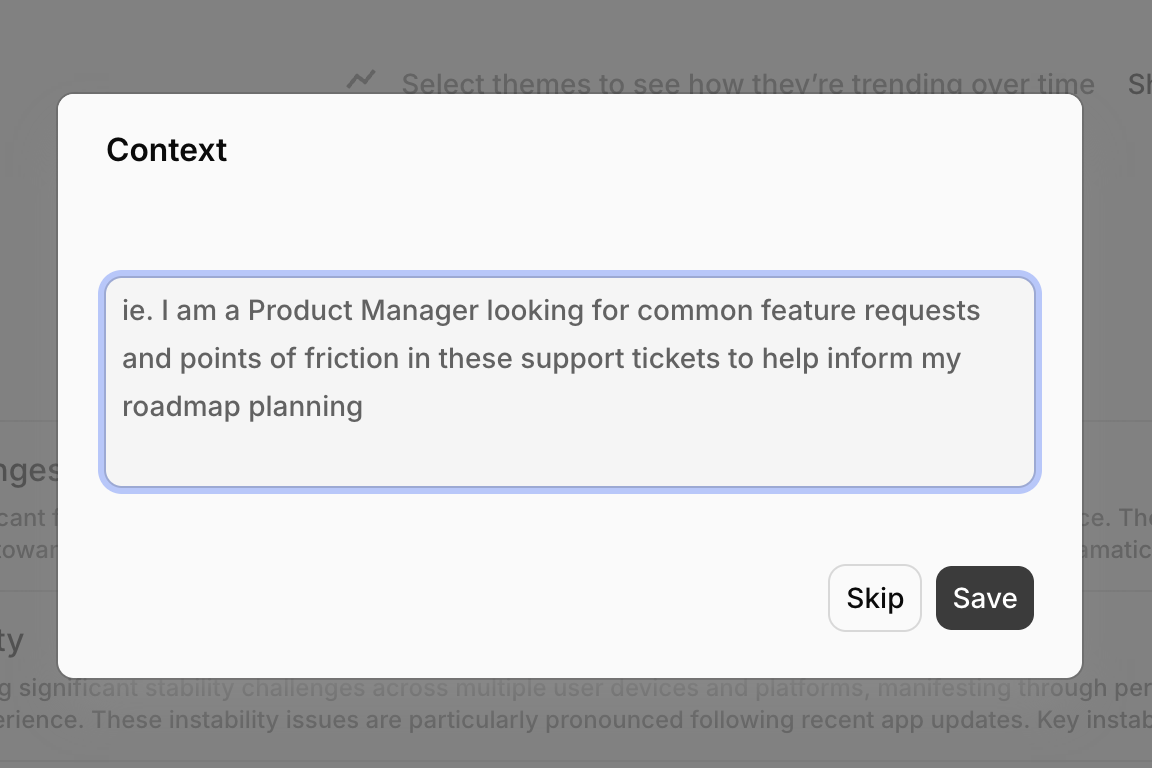
Overview
Defining your Channel’s context and topic descriptions enables you to guide Dovetail’s AI to focus on what matters most to you and capture the important topics and themes that your organization wants to track over time.Defining your Channel’s Context
When adding context to any channel, follow these core principles:- Focus on 2-3 main goals that apply across all your data
- Keep it under 400 characters and be concise
- Use natural language with clear structure that helps you understand the content in a glance
- Avoid overly detailed specifics to prevent filtering out other valid insights
- Specify your role to direct AI to analyze data from your perspective
Context Strategies to Consider
- Umbrella Approach: Create broad context that encompasses all team needs:
- Use company-wide objectives as the foundation
- Focus on customer experience or business outcomes
- Avoid team-specific jargon or priorities
- Emphasize shared metrics and goals
- Perspective Integration: Explicitly acknowledge different viewpoints
- Outcome-focused context: Center on business results rather than team functions
- Journey-based context: Organize around customer journey stages
Defining Topic Names & Descriptions
While you can utilize the Dovetail generated topics & descriptions, you are always able to adjust the both the topic names and/or the descriptions (or add your own).Topic Name Best practices
- Use clear wording that immediately conveys the high-level category
- Keep titles concise (2-3 words when possible)
- Use customer language rather than internal jargon
- Avoid overlapping categories that could confuse classification
- Use consistent naming patterns across similar topics
Topic Description Best Practices
- Explain the theme’s scope clearly in 1-2 sentences
- Use keywords that customers might actually use
- Guide the AI on what to look for and what to exclude
- Keep under 200 characters for optimal performance
- Include specific examples but make sure the example and expectation matches the most common meaning in general English
Examples
Below you will find Context and Topic descriptions examples for six of the most common types of data customers- NPS/CSAT
- App Store Reviews
- Support Tickets
- General Product Feedback
- Churn/Cancellation Reasons
- Product Reviews
Context Examples
Customer Experience Manager: I am a Customer Experience Manager analyzing NPS and CSAT responses to understand what drives customer satisfaction and loyalty. Help me identify the key factors that create promoters versus detractors, understand specific touch-points that impact satisfaction scores, and discover actionable insights for improving overall customer experience. Focus on both positive experiences we should amplify and negative experiences we need to address.Product Manager: I am a Product Manager using NPS/CSAT feedback to guide product strategy. I want to understand which product features and experiences most strongly correlate with customer satisfaction. Highlight specific product strengths that drive positive scores and pain points that create detractors. Include any suggestions for product improvements or new features that could increase satisfaction.Multi-team: We are Product, Marketing, and Customer Success teams jointly analyzing customer satisfaction feedback to drive company-wide improvements. We want to understand satisfaction drivers across the entire customer journey, identify both product and service factors that impact scores, and discover insights for improving customer experience, product development, and go-to-market strategies. Focus on actionable insights that can inform product roadmaps, marketing messaging, and customer success programs.Topic Description Examples
| Topic Name | Description |
|---|---|
| Product Ease of Use | Feedback about how intuitive, simple, or complex customers find the product. Includes comments about user interface clarity, workflow efficiency, and learning curve experiences. |
| Customer Support Quality | Experiences with our support team including response times, helpfulness, knowledge level, and overall satisfaction with support interactions. Covers both positive and negative support experiences. |
| Value for Money | Perceptions about pricing fairness, ROI, cost-benefit analysis, and whether customers feel they’re getting good value. Includes comparisons to competitor pricing and budget concerns. |
| Product Reliability | Comments about system uptime, stability, consistent performance, and trustworthiness. Includes feedback about bugs, crashes, and technical reliability issues. |
| Feature Completeness | Feedback about whether the product meets customer needs, missing functionality, and gaps in capabilities. Includes requests for additional features and comparisons to competitor offerings. |

